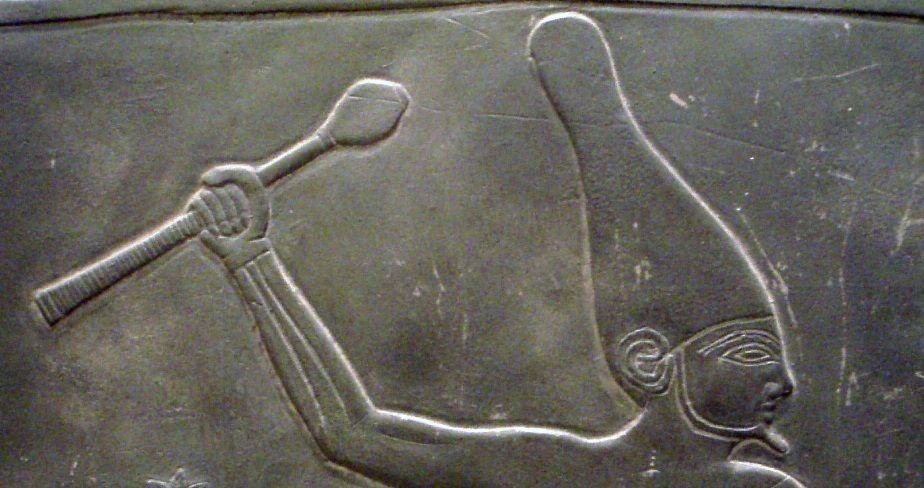Cast Thy Spell, Oh Daydream Sorcerer!

If you’ve spent any time in the menagerie of a young household, you’ve had an experience like this: A 6-year old boy trots out into the living room wearing a brightly colored, plastic bowling pin that’s been taped to a toy firefighter helmet. Bare-chested and loins girded with a pillow case, he thunderously commands his siblings to build a pyramid.
His mother looks at you with affectionate bemusement and explains, “We’ve been studying ancient Egypt this week.”
What I love about those moments is the part of the story we don’t see.
There was a point at which that child had a vision: the hedjet, the a crown of the kingdom of upper Egypt (that looks like a bowling pin), could transform him into this great king of old. He, too, could don a bowling pin and command the people’s of his world with authority and might.
He rummages through his cluttered piles of atomized toy sets until he finds the bowling pin long abandoned under his bed (and only used for bowling once) and then, looking around for a head piece of some kind, concludes the fire fighter helmet should do. Now he just needs tape.
Then mother receives a seemingly random procurement request, “Mom, can I have some tape?”
“What for?” She asks, wisely.
“I’m making a crown.”
“Okay, But don’t use a lot.” She says, again wisely, fishing the tape out of an overstuffed drawer. “Maybe like this much.” She motions.
“Okay.” He replies, running back to his his forge.
It takes quite a bit of tape to attach the pin to the helmet, but after a few tries, it seems effectively secure, so he drops the empty roll of tape on the floor and takes his creation to the bathroom mirror.
Admiring his regal success, his mind flashes to the images in his book. Pharaohs don’t wear shirts. So off comes the hat and the shirt falls to the bathroom floor as he crowns himself again. That’s better, but they also wear white skirts.
He reflects on this a moment. Where can he get a white skirt? A flash of genius strikes. Running back to his room, he pulls the pillow case off his pillow and wraps it around his waist.
But his jeans poke out the bottom. That won’t do. So off come the jeans and the skirt is tucked into the blue elastic band of his Spider-Man briefs.
Back to the bathroom and his regal stature stares back at him with more glory than Tutankhamen himself.
Total success!
With all the swag befitting his station, he struts out into the living room where the adults are perennially couched and processes toward his siblings who instantly understand their role and take their place as the slave class.
The Magical Bridge
Unbeknownst to this self-crowned leader of ancient Egypt, he has done what every education leader hopes for: total, self-directed, ownership and creative interaction with the course material outside of the classroom.
But what educators often miss, especially with teenage and adult students, is that the bridge between his lesson and his game was his imagination.
We never grow out of this love of re-creation and period play acting. Streaming services are laden with period films and TV shows, but because they’re framed by the dignity-granting bezels of our screens or safely fenced in by the orchestra moat, we we call it “entertainment” or “an evening out”. But if we’re honest, it’s more like indulging our inner love of child’s play without contributing creative investment.
This then, is the essential task of the teacher: Inspiring topical day-dreaming that is so powerful it breaks out into the real world.
The X-Files and the Art of Imagination
There’s an The X-Files episode where the lead detectives tasked with investigating paranormal events are dispatched to a house that is experiencing deadly encounters with monsters.
They eventually discover that the source of the monsters is the imagination of a young boy who’s thoughts are so powerful, they actually can create things in the real world.
Since most of you reading this haven’t watched the episode, I won’t spoil the coda that makes up the moral of the story, but I will say I highly recommend it.
The point is not that, left to their own, students’ imaginations can produce monsters that break out into the real world and cause FBI investigations (though maybe it should be). The point is that the task of the education leader is to become daydream sorcerers.
Enchantment Education
When I daydream, my mind wonder anywhere it pleasees. And usually this day dreaming is away from course material because the content has become dislodged from the mental flow. But it doesn’t have to be that way. Our minds can drift toward content just as easily. But the content has to distinguish itself as a fitting object for daydreams.
That requires art.
Anytime our bodies are someplace our minds aren’t, it should make us ask, why? Because the knife of daydreams cuts both ways. We’ve all that moment when our mind wonders back to something somebody has said. That’s topical day-dreaming and I’m becoming convinced it’s the pay dirt of education.
When my mind freely wonders to course material, it’s due to some sort of imaginative enchantment with the idea. The content has become, in some way, mentally manipulable.
That enchantment will usually bubble up as a mention in a conversation, a quote in text message, a web search, a doodle. It’s occasionally so powerful, it becomes a Thank You card, “I don’t know if you remember this, but one time you said…and I’ve been thinking about it ever since.”
Art and Entertainment
So how do we do it? I think the answer is art, in the broadest sense of the word.
Art inspires art which is shorthand for saying imagination is contagious.
Writing, painting, presentation, song. Every tool in an artists toolbox is available to the education leader so that material can spark an imaginative reaction. That’s education.
It is not, however, entertainment. I’ve seen so many would-be education leaders confuse the two that it deserves special mention.
Educative art is taking content and animating it with artistic taste and competency.
Entertainment is taking what the leader thinks people would rather be thinking about and trying to cram the content into it. But serving chocolate covered vegetables ruins the chocolate and the vegetables.
The reason people hate health food is not because health food is bad, but because health food tries to hard to be alternative junk food (“Look, it’s not carby pasta, it’s zucchini that lookslike pasta!”)
The tragedy of this game is that it fools nobody and turns people off from ever trying healthier foods when the truth is, genuinely tasteful, well prepared healthy food can be amazing in it’s own right.
Of course, nobody will know that because the marketing-minded health nut is trying to be cool like the fast food joint while also clinging to her principles. Nobody is buying that. Not in a health food pitch and not in a classroom.
It’s also just strategically stupid.
Strategy is Choice
As Lafley and Martin argue,, strategy is choice: choosing where to play and how to win there.
Why do education leaders continually choose to play in domains owned by mental fast food companies? Because they either (1) think their content doesn’t have the culturally creative power to ignite daydreaming or (2) they don’t think they themselves have the cultural clout to cast the spell.
So they resort to cringy attempts at making their content “cool” by dressing it in what the cool kids wear, not realizing that clothes don’t make people cool; cool people make clothes cool.
The content has to drive the art and the art has to be created with taste and creativity driven by a deep love that wants to show off what the content is rather than trying to hide it under layers of what it isn’t but what we think people wish it were.
Cast Thy Spell!
When a child marches through his toy-strewn kingdom, it’s silly and joyous. Focused and free. But we can’t count on that for every subject. That’s why learning leaders have a job: to model that silly, joyous, focused, free delight in the subject and cast it on the learners.
Mostly, that spell begins with the craft that all artists have: Theme, plot, character, conflict, show-don’t-tell, atmosphere, tone, pacing.
All of these artistic intentionalities are choices. Choices that are always asking, does this tell the story? Or, more pointedly, what is this learning moment about? That question in hand, we can then begin carefully putting everything about the moment into that cauldron.
Why this topic?
Why these students?
Why this space?
Why this seating arrangement?
Why this graphic?
Why this question?
Why this opening sentence?
Why these points?
Why this activity?
Why this whiteboard?
Why this hour of the day?
Why this point in the semester?
Why this homework assignment?
Why this quiz?
What is about every micrometer of this spell casting session that intentionally connects back to intention of this moment?
What I hear from professional educators all the time is, “Oh, I don’t have control over any of that. I’m given the syllabus and have to just go with it.”
And they’re right. These educators are given their space, given their times, given their students, given their topics, given their assignments, given their due dates. And out of that primordial ooze of passivity emerges a class that is also passive. Then they sit with bureaucrats in their committee meetings, scratching their hands saying, “How can we make our students active participants in this class?”
Nothing but the best and brightest…
But true daydream sorcerers are active creators of the learning environment. Everything about slinging imagination spells is as much about timing, space, and material as it is about delivery. They are learning auteurs who are going to see their learning experience come to life no matter what. Because, fundamentally, that’s the magic they live for.

Member discussion